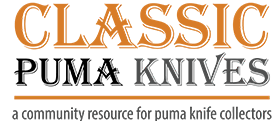There are two very common questions I receive, almost daily. Can you help me identify this knife ? What is my knife worth ? In this article, I am going to address the later, the worth of a knife. It is complicated and deeply subjective anytime that it is asked and answered. Here is why…..
To a collector, there are several factors which affect the value of a knife. The Age, Condition and Rarity. Also, additionally, is it complete with the correct box, warranty card ( if applicable ) and other paperwork ?
The AGE. If they thought about it, most collectors would agree that a knife produced in the 1969 should be worth more in than one made in 1999. Not many people give it much thought, but should. It is more logical that early and old survivors in excellent condition should bring a premium price when compared to an equivalent one made only a few years ago. It was an age that most knives were bought to be used and not collected making them rare survivors.
The CONDITION. The most important aspect of determining price is the condition of the piece, especially the condition of the blade. Like the numismatic market for coins, prices for knives drop dramatically for flaws, especially controllable ones like rust and corrosion if allowed to occur on the blade. The term, Mint, Near Mint, Excellent, Good. Fair and Poor are all terms used in describing the blade. All of these terms are associated with price drops along the way down. In my opinion, pieces solely made for the collectors market, should be in Mint to Near Mint condition to be accepted by most collectors since they were never intended to be used. There is no good reason for them to be otherwise.
The RARITY. There are some Puma models, that for one reason or another, were never in high demand with hunter’s or dealers or distributors. These models, typically, were only made for a few years before halting production. In most cases during these years, production numbers suffered low demand, leading to managements decisions to stop production. They all can’t be winners, right ? I will give you a few examples. The Falknersheil, the Left Handed Trapper and the Alaskan. All of these models had one thing in common. Low numbers. There were not many people practicing Falconry to buy them. How many left-handed Trappers do you really know ? What killed the Alaskan, in my opinion was poor demand due to a poor blade design. It just was not accepted by the hunting community.
So, conceptually and to the point of all of this. Prices should go through the roof for collectors if you have an OLD knife, In Mint condition that is extremely Rare. RIGHT ?
Here is where it gets complicated and the reason I flinch every time I get asked the question, What is my knife worth ?
AGE. Prices should, but in most cases, do not increase with age, at least appreciably. Age does not represent money in the bank. A Hunter’s Companion, from the 60’s , for example, is not priced appreciably higher than the one from the 80’s. It is very wrong but it is the reality of the situation. Additionally, even though they were made in the 40′ and 50’s Scout knives just don’t bring a lot of money in. They were mass-produced, there are many out there and they are very popular with just a few people. Maybe that will change, maybe not.
CONDITION. Beauty is in the eyes of the beholder. What I call in Mint Condition may not viewed the same way by another person. We cannot agree on the standard by which blades are evaluated. For better or worse, some are more or less stricter in their concept of blade condition. It is a very subjective mater to each person. Seller’s and buyer’s must come to an agreement on the condition and therefore the price associated with that condition. I have talked to some sellers who insisted that the blade is Excellent only to get it in a used and sharpened condition.
RARITY. Finally, we all can agree to something ! Typically, we can usually all agree to what is rare and isn’t. It is based on facts and numbers in most cases. If you don’t see one on eBay in a few years, you know it is rare. One can make the case for this. But that brings up the final point. Do we really agree on what something should cost if it is rare. I think not !
I will say this to answer to finally answer the question ! Your knife is worth what you are willing to sell it for and what someone else is willing to pay for it. That, in a nutshell, is what your knife is worth. It is subjective and the price fluctuates, sometime wildly. It depends on where you are in the world, what your economy is doing, where collectors are heading. The age, the condition and the rarity are all important . Oh, and by the way, you should have the original box and paperwork because in the last few years, collectors have begun to insist on it. That affects the price too.
I think, for some, this will be a let down to find out there is no easy or definitive answer but that is the reality of it all and the reason I flinch a little… when asked the question; what is my knife worth ?
All of this, of course, is just my opinion.
